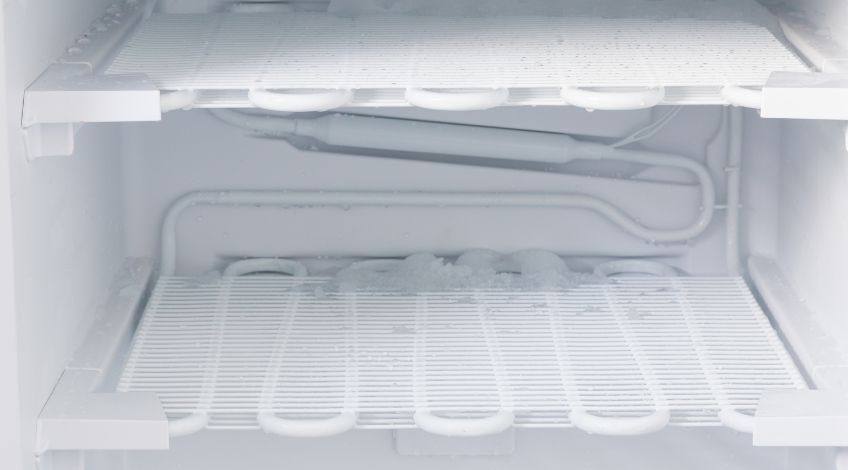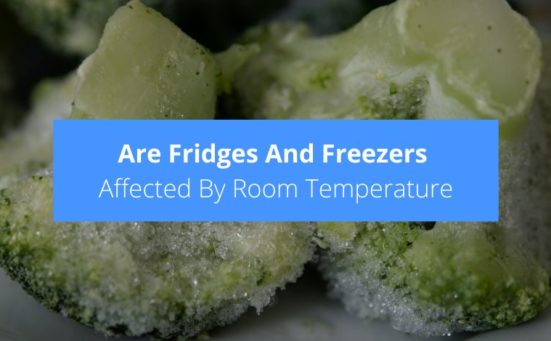
Ice At Bottom Of Freezer? (do this)
It’s not uncommon to get ice forming at the bottom of the freezer and the solutions to this fault are often simple to implement. If you have ice forming at the bottom of your freezer, keep reading to find out what causes it and how to fix it.
If you are looking for information for a specific freezer, refer to your user manual. If you don’t have a user manual check online for your make and model by going to the brand’s website.
What Causes Ice To Form At The Bottom Of The Freezer?
There are several reasons for ice to form at the bottom of the freezer and many can be remedied quite simply. It could be;
The Freezer Door Is Not Shut Correctly
If the freezer door is not fully shut, ice will melt and fall to the bottom of the freezer as water and refreeze. It could also be that the door seal on the edge of the door has become partially unattached. This is easy to check, just run your hand around the door and see if you can feel any cold air. If you can check the door seal and replace if necessary.
The Freezer Is Near A Heat Source
If your fridge/freezer is positioned in direct sunlight, or close to a radiator or any other heat source, it will need to work harder to keep cool. This can cause ice to build up, melt then refreeze in a number of places, but especially the bottom of the freezer. Fridge/freezers work best when kept in rooms with an average temperature of between 10 to 38C (50 to 100F).
The Freezer Door Is Opened Often
If your kitchen is humid, just opening the freezer door could cause ice to build up. Once the door is opened warm air rushes inside the freezer which will cause ice to initially melt. This melted ice will fall to the lowest point – the floor of the freezer and then eventually refreeze. Try getting into the habit of opening the freezer door and removing everything you need in one go. This prevents the door from being open for too long.
The Freezer Needs Ventilation
Check the freezer’s air vents and be sure that nothing is preventing air from circulating correctly. For the freezer to work correctly, it needs to have air circulating to keep all of the freezer at the same temperature. Try to spread all of the items in the freezer around as much as possible and check that the air vents are clear at all times.
Hot Foods Placed In The Freezer
If you have placed hot or even warm food inside the freezer, it can raise the humidity of the freezer and this can cause ice to form. Always allow food to cool completely before putting it in the freezer.
Remove Any Dust From The Back Of The Appliance
Keeping the rear of the freezer clear from dust and debris will prevent the accumulation of ice from building up inside the freezer. Most manufacturers recommend vacuuming the back panel of the freezer every 6 months to keep it clear of dust and detritus. Be careful not to remove the rear panel as this could cause an electric shock.
Problems With The Icemaker
If your freezer has an ice maker, it could allow warm air to enter the freezer. Ice makers have a flap which is there to prevent any cool air from escaping from the freezer. It also prevents warm air from entering the freezer. Check inside the ice maker for any ice that might be preventing the flap from shutting properly.
The Freezer Needs Defrosting
If there is a large build up of ice in the freezer, it is probably time to defrost the freezer. As more and more ice accumulates inside the freezer it can cause any number of problems. From the freezer door not shutting correctly, to blocking the air vents inside the freezer. Follow our easy to follow guide to correctly and safely defrost your freezer.
How To Defrost The Freezer

If your freezer has a large build up of ice it is best to remove it to allow the freezer to work more efficiently and also allow you to store more food in the freezer correctly. To defrost the freezer just;
- Empty the freezer of all food
Remove everything from the freezer and store it in the fridge or somewhere cool. - Disconnect the freezer from the electricity supply
Remove the plug from the socket or flick the circuit breaker. - Spread something absorbent around the floor
Place some towels around the floor in front of the freezer to soak up any water that falls from the freezer. - Place hot water inside the freezer
Carefully place a couple of bowls filled with hot water onto the shelves of the freezer to speed up the melting process. Or fill a spray bottle with hot water and spray the frost with hot water to melt it. - As the ice melts, remove any water
Use towels to mop up the water as the ice melts and keep going until all of the ice is gone and the freezer is completely ice free. - Ensure the freezer is completely dry
Once all of the ice has successfully melted, be sure to remove all of the water using a towel to completely dry the freezer. - Reconnect the power
Once all of the ice is gone, plug the freezer back in and restock it.
Ice Build Up Behind The Freezer’s Back Panel
Sometimes it appears all of the ice is gone but there could be ice behind the inside back panel of the freezer. This can be because there is a drainage tube that has become blocked. The best way to clear this is to either allow the freezer a full 24 hours to defrost, or remove the inside back panel to allow the ice to melt quicker.
Warning: The panels and components inside a freezer are often made from plastic which could easily deform or break if too much pressure or heat is applied to them. Always exert gentle pressure and if you do use a hairdryer to speed up the ice melting process, keep it moving at all times and never concentrate the heat onto one area for too long.
The thing to remember is that the back panel is only made from plastic which will be easy to break. So take care when trying to remove the back panel. On most freezers the back inside panel is held in place by 4 screws, one at each corner. These screws should unscrew easily enough, but don’t exert too much pressure on the rear panel once the screws have been removed.
In some cases the rear panel is held in place by plastic clips or sometimes the panel simply clicks into place. For these panels you will need to use extra caution because if this type of panel is stuck, it is extremely easy to break them if you use too much pressure.
You could help speed things up by using a hair dryer carefully without allowing the hairdryer to touch any surface inside the freezer, wet or otherwise. Once the rear panel is removed it will be easy to see where the drainage channel is and whether it is blocked or not.
If the drainage channel is blocked, try pushing a pipe cleaner through the hole at the back of the channel after trying to melt any ice blocking the hole using the hairdryer carefully. It should be a simple task of just refitting the rear panel and plugging the freezer back in again.
If after all of this, your freezer still forms ice at the bottom, and you are sure that the door seals are fine, the drainage tube isn’t blocked and the vents are clear, we advise contacting the manufacturer for more information.
Frequently Asked Questions
There are several reasons why you could have a buildup of ice in the bottom of your freezer. It could be that you leave the door open for too long which allows warm air to enter the freezer, the air vents could be blocked, the door seal could need replacing, the freezer could be too close to a heat source, you could have placed hot food in the freezer or the drainage tube could have become blocked.
In most cases the frost in the freezer will go away on its own because most modern freezers have defrost programs. If yours doesn’t, then you’ll need to defrost it manually.
You can pour warm water into a bowl in the freezer to help defrost it faster once all of the food has been removed.
It can take anywhere between 2 to 4 hours for a freezer to defrost. If there is a heavy build up of ice it could even take up to 24 hours to defrost it completely.
You should never use a car de-icer for the freezer as the chemicals used to make the car de-icer are not safe for human consumption, and should never be used with food.


![How Does The New Energy Rating System Work For Appliances [A-G rating system]](https://checkappliance.co.uk/wp-content/uploads/2023/11/How-Does-The-New-Energy-Rating-System-Work-For-Appliances-A-G-rating-system-551x341.jpg)

